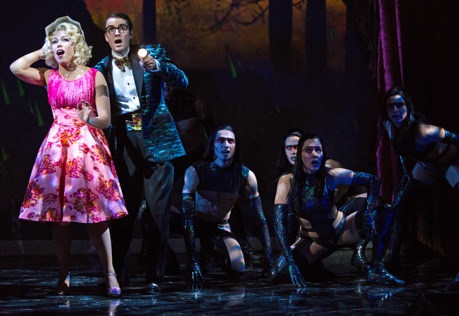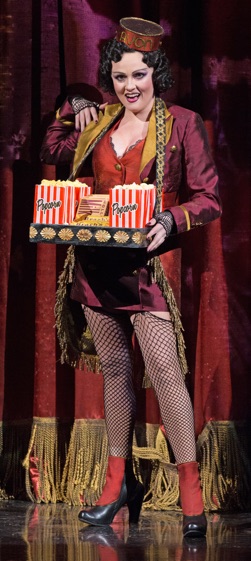Reviews 2018






✭✭✭✩✩
music, lyrics & book by Richard O’Brien, directed by Donna Feore
Stratford Festival, Avon Theatre, Stratford
June 2-December 2, 2018
Narrator: “Lost in time, and lost in space... and meaning”
Eyebrows were raised when the Stratford Festival announced it would present The Rocky Horror Show in its 2018 season and eyebrows will be raised even higher once audiences see the production which is even lewder than the 1975 cult film. Richard O’Brien’s 1973 musical is an homage to the cheesy sci-fi films of the 1950 and ‘60s before before 2001: A Space Odyssey (1968) turned sci-fi films into a respectable genre and Star Wars (1977) turned them into multimillion dollar franchises. The show is filled with strong performances, especially from Dan Chameroy as the transvestite mad scientist Dr. Frank N. Furter, and at least the first act of the musical is a lot of fun. The question some may have is why they are paying up to $163.49 to recreate an experience that in 1975 cost about $2.00.
For those under 50, the music deals with the ordinary, sexually repressed 1950s-style couple Brad and Janet, whose recent attendance at a wedding has given them the idea that perhaps they should marry, too. Unluckily, for them their car breaks down and the only habitation nearby is a forbidding castle. There they go to use a phone to call for help (the musical and the movie are from the 1970s, remember). To their dismay, the castle is inhabited by degenerate humanoid aliens whose look would later inspire goth fashion. Their leader is the self-proclaimed “sweet transvestite” Dr. Frank N. Furter, who, after one failed experiment, has created the perfect muscled boy toy, Rocky, for his pleasure.
Though it will be heresy to hardened Rocky Horror fans, from an objective point of view the musical goes seriously downhill in Act 2. Its highlight occurs right at the beginning. Since there is no phone Brad and Janet must spend the night, during which the pansexual Dr. Furter deflowers both of them which each finds theoretically distasteful but ultimately pleasurable. Feore decides to illustrate the sexual interaction with the use of a rod or rods (geddit?) pressed against the satin bed sheets. Janet’s release from virginity causes her to fall into lust with anything male, especially the willing Rocky. For no particular reason except to fill out the act, Frank decides that they should all put on a show. This done, Frank is made to realize that he has angered his alien overseers by too much dalliance with humans and will have to pay a dreadful penalty.
One factor which makes the already ridiculous plot even funnier is that it is narrated by a so-called “expert” whose goal it seems is to draw some sort of moral for the audience about the perils of associating with sexual degenerates. More important than this, however, is the tradition of audience participation that developed when the film became a midnight movie at second-run movie houses (remember this is before DVDs and Netflix). Over the years a series of call-backs took form in which the audience was to speak back to the screen in the pauses in dialogue. Any time Brad spoke, the audience called him “Asshole”, and every time Janet spoke, she was called a “Slut”. There are a huge range of call-back lines that basically form a parallel script to the fixed script of the movie. You can even view these call-back scripts online.

Not only that, but audience members would dress up as their favourite characters and act out the movie script, mouthing the words, in front of the screen. Those in the know, would also come to the movie prepared with a set of props – including, toast, rice, confetti, cards, rubber gloves and hot dogs – which were to be used to mimic specific parts in the movie. Thus squirt guns would start shooting in the air when Brad and Janet get out of the car into the rain. The film and then later the live show became a kind of elaborate adult panto or some would say secular mass during which the audience celebrated freedom from all forms of societal norms in dress, sexuality and taste.
Now that it is 2018 and at least 48 years since most of the audience would have experienced the cult of The Rocky Horror Picture Show first hand, there are likely very few attendees who even remember what the call-backs are. As it happened on opening night, there was a group in the back of the auditorium who knew exactly what to say and when, their call-backs perfectly timed with the show. One could only assume that this was a claque hired to prod the aged viewers of the original movie into remembering what to do. It did, however, prod some into making up new call-backs which, as with any audience-generated material, was sometimes was funny, sometimes not.
If every presentation of The Rocky Horror Show at Stratford does have such a claque, that is all for the good since it is the call-backs which make the show the unique experience it is. Without them, as was the case with the CanStage revival in Toronto in 2007, the show is simply a faux-1950s style musical built on the now-defunct aesthetic of camp, i.e. that it is “so bad it’s good”. Though, as often with once-camp items, the only part that remains is the “so bad”.
With a “so bad it’s good” aesthetic, high production values are not merely pointless but counterproductive. Yet, given that this is a musical at the Stratford Festival, the Festival also wants to show that its patrons that their $163.49 is embodied on stage. Thus, the show provides us with such paradoxical items from set designer Michael Gianfrancesco as an entirely new red velvet curtain for the Avon Theatre that has been distressed and patched with the gold fringe falling off in places in an expensive attempt to recreate the look of a dilapidated curtain in old second-run movie house.

Where the design works best is when it is simplest. When Brad and Janet are driving their car, they are simply standing behind a cut-out of the front of a car with their heads in the glassless window. Cheap and deliberately phoney is what the show asks for but what in this production it seldom receives.
As it happens virtually all the plot and both of the show’s two most memorable songs appear in the first act – “Time Warp” and “Sweet Transvestite”. Some may remember the Usherette’s song “Science Fiction” that both begins and ends the show. Yet, it is no accident that for the encores the cast sings “Time Warp” twice and “Sweet Transvestite” once. What makes listening to the music difficult is that it is over-amplified. This is evident from the Usherette’s first rendering of “Science Fiction”. During Act 2, the volume knob is gradually turned up so that by the time of the encores the volume has become painful and the sound is distorted. Earplugs are advisable.
Given the nature of the piece, the cast has to master the art of deliberately bad acting and has to soldier on despite the volleys of call-backs. Director Donna Feore has assembled just such a cast. Dan Chameroy, who has spent quite a lot of time in drag either as Miss Trunchbull in Matilda the Musical or as Plumbum in Ross Petty’s pantos, is absolutely perfect as Dr. Frank N. Furter. Besides actually looking good in a corset and heels, he can put across songs like “Sweet Transvestite” with exactly the right level of dubious sensuality. He has spot-on comic timing, Mae West-like dialogue delivery and, because of his panto experience, super improv ability.
Brad and Janet are the well-chosen Sayer Roberts and Jennifer Rider-Shaw. Roberts is delightful at playing Brad as a 1950s-style uptight nerd. The real surprise, however, comes in Act 2 when he sings his big song “Once In A While” (deleted from the film) and reveals he has an excellent singing voice and a real feel for rock ballads. Similarly, Rider-Shaw is amusing as the initially prim and proper Janet. From her performance as Josephine in H.M.S. Pinafore last year, you would never know that she is as adept at singing rock songs as operetta as demonstrated by her strong rendition of “There’s A Light” in Act 1. Rider-Shaw makes Janet’s sudden transformation from prude to nymphomaniac very funny.
Erica Peck starts the show off well with a fine account of “Science Fiction” in a clear, strong voice and with such precise diction that none of the song’s numerous allusions to old sci-fi movies are lost. She ends the song with a great imitation of Gloria Swanson’s scary close-up look in Sunset Boulevard (1950). Peck also plays the alien Magenta, but sadly is given little to do in that role.

Meanwhile, Steve Ross is absolutely hilarious as the pedantic, moralizing Narrator, more narrowly defined as a Criminologist in the movie. Of the cast only he and Chameroy act as if they hear any of the audience call-backs. Like Chameroy, Ross is just as skilled at improvising a response or using merely an astute pause or significant stare to get a laugh. One clever aspect of Donna Feore’s direction is to have the Narrator’s clothing gradually change with each entrance until by the end he is dressed just like Frank, the degenerate he has warning us so portentously against.
People who go to the The Rocky Horror Show expecting to see the same acrobatic choreography Feore lavished on The Music Man this season will be disappointed. Here for the six “Phantoms” that haunt the castle, she imitates the kind of generic back-up dancing common to the appearances of rock singers on 1950s and ‘60s television shows. Having most of the cast in high heels must also inhibit movement so that Feore signals sensuality by generalized writhing mixed with pelvic thrusts.
As a raunchy, adult-themed musical, The Rocky Horror Show stands rather obviously as counter-programming to the wholesome family musical The Music Man. Rocky Horror has something to offend puritans on both the right and left. For those on the right, at whom the musical was aimed, this celebration of non-binary sex roles, orgiastic behaviour and freedom from all social mores will be the epitome of all it despises. Yet, when it was written O’Brien could not know that puritanism would also arise on the left in the form of political correctness. The notion that Janet would not only enjoy non-consensual sex but be turned into a tramp because of it would now be considered degrading to women to say the least. The treatment of the murder of Rocky’s predecessor, Eddie, as comic would also be thought disturbing. And we won’t even examine the cavalier conflation of “transsexual” and “transvestite” in the text.
If you must, do see The Rocky Horror Show for the principals’ performances. But do recognize that the show is a cult musical precisely because it is severely flawed. And do hope there is a claque who knows all the call-back lines because without them the show would be as much fun as an unlit disco ball.
©Christopher Hoile
Note: This review is a Stage Door exclusive.
Photos: (from top) Dan Chameroy as Dr. Frank N. Furter and George Krissa as Rocky; Jennifer Rider-Shaw as Janet and Sayer Roberts as Brad with the Phantoms; Erica Peck as the Usherette; Steve Ross as the Narrator. ©2018 Cylla von Tiedemann.
For tickets, visit www.stratfordfestival.ca.
2018-06-05



The Rocky Horror Show





